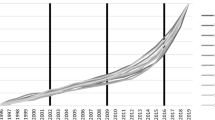Abstract
Using Institute for Scientific Information (ISI) data, this paper calculated institutional self citations rates (ISCRs) for 96 of the top research universities in the United States from 2005–2007. Exhibiting similar temporal patterns of author and journal self-citations, the ISCR was 29% in the first year post-publication, and decreased significantly in the second year post-publication (19%). Modeling the data via power laws revealed total publications and citations did not correlate with the ISCR, but did correlate highly with ISCs. California Institute of Technology exhibited the highest ISCR at 31%. Academic and cultural factors are discussed in relation to ISCRs.
Similar content being viewed by others
References
Adams, J. D., Clemmons, J. R., Stephan, P. E. (2004), Standing on Academic Shoulders: Measuring Scientific Influence in Universities. Cambridge, MA: National Bureau of Economic Research, (NBER Working Paper No. 10875)
Aksnes, D. W. (2003), A macro study of self-citation, Scientometrics, 56(2): 235–246.
Aksnes, D. W. (2006), Citation rates and perceptions of scientific contribution, Journal of the American Society for Information Science and Technology, 57(2): 169–185.
Anseel, F., Duyck, W., De Baene, W., Brysbaert, M. (2004), Journal impact factors and self-citations: Implications for psychology journals, American Psychologist, 59(1): 49–51.
Ausloos, M., Lambiotte, R., Scharnhorst, A., Hellsten, I. (2007), Andrzej Pekalski Networks of Scientific Interests with Internal Degrees of Freedom through Self-citation Analysis, Arxiv preprint arXiv:0710.1800.
Baldi, S. (1998), Normative versus social constructivist processes in the allocation of citations: A network-analytic model, American Sociological Review, 63(6): 829–846.
Demaria, A. N. (2003), A report card for journals, Journal of the American College of Cardiology, 42(5): 952–953.
Engqvist, L., Frommen, J. G. (2008), The h-index and self-citations, Trends in Ecology & Evolution, 23(5): 250–252.
Falagas, M. E., Kavvadia, P. (2006), “Eigenlob”: self-citation in biomedical journals, FASEB Journal, 20(8): 1039–1042.
Fassoulaki, A., Paraskeva, A., Papilas, K., Karabinis, G. (2000), Self-citations in six anaesthesia journals and their significance in determining the impact factor, British Journal of Anaesthesia, 84(2): 266–269.
Fowler, J. H., Aksnes, D. W. (2007), Does self-citation pay? Scientometrics, 72(3): 427–437.
Frandsen, T. F. (2007), Journal self-citations — Analysing the JIF mechanism, Journal of Informetrics, 1(1): 47–58.
Gami, A. S., Montori, V. A., Wilczynski, N. L., Haynes, R. B. (2004), Author self-citation in the diabetes literature, Canadian Medical Association Journal, 170(13): 1925–1927.
Garfield, E., Welljams-Dorof, A. (1992), Citation data: their use as quantitative indicators for science and technology evaluation and policy-making, Science and Public Policy, 19(5): 321–327.
Glänzel, W., Debackere, K., Thijs, B., Schubert, A. (2006), A concise review on the role of author self-citations in information science, bibliometrics and science policy, Scientometrics, 67(2): 263–277.
Hellsten, I., Lambiotte, R., Scharnhorst, A., Ausloos, M. (2007), Self-citations, co-authorships and keywords: A new approach to scientists’ field mobility? Scientometrics, 72(3): 469–486.
Hyland, K. (2003), Self-citation and self-reference: Credibility and promotion in academic publication, Journal of the American Society for Information Science and Technology, 54(3): 251–259.
Kelly, C. D., Jennions, M. D. (2006), The h index and career assessment by numbers, Trends in Ecology & Evolution, 21(4): 167–170.
Lawani, S. M. (1982), On the heterogeneity and classification of author self-citations, Journal of the American Society for Information Science, 33(5): 281–284.
Macroberts, M. H., Macroberts, B. R. (1989), Problems of citation analysis: A critical review, Journal of the American Society for Information Science, 40(5): 342–349.
Maczelka, H., Zsindely, S. (1992), All well if starts well? Citation infancy of recently launched chemistry journals, Scientometrics, 25(2): 367–372.
Moed, H. F. (2002), The impact factors debate: the ISI’s uses and limits, Nature, 415(6873): 731–732.
Motamed, M., Mehta, D., Basavaraj, S., Fuad, F. (2002), Self citations and impact factors in otolaryngology journals, Clinical Otolaryngology, 27(5): 318–320.
Nisonger, T. E. (2000), Use of the Journal Citation Reports for serials management in research libraries: An investigation of the effect of self-citation on journal rankings in library and information science and genetics, College & Research Libraries, 61(3): 263–275.
Persson, O., Beckmann, M. (1995), Locating the network of interacting authors in scientific specialties, Scientometrics, 33(3): 351–366.
Rousseau, R. (1999), Temporal differences in self-citation rates of scientific journals, Scientometrics, 44(3): 521–531.
Schreiber, M. (2007a), A case study of the Hirsch index for 26 non-prominent physicists, Annalen Der Physik, 16(9): 640–652.
Schreiber, M. (2007b), The influence of self-citation corrections on Egghe’s g index, Arxiv preprint arXiv:0707.4577.
Schreiber, M. (2007c), Self-citation corrections for the Hirsch index, Epl, 78(3): 6.
Seglen, P. O. (1997), Citations and journal impact factors: Questionable indicators of research quality, Allergy: European Journal of Allergy & Clinical Immunology, 52(11): 1050.
Thijs, B., Glänzel, W. (2005), The influence of author self-citations on bibliometric meso-indicators. The case of European universities, Scientometrics, 66(1): 71–80.
Tsay, M. Y. (2006), Journal self-citation study for semiconductor literature: Synchronous and diachronous approach, Information Processing & Management, 42(6): 1567–1577.
Van Raan, A. F. J. (1998), The influence of international collaboration on the impact of research results, Scientometrics, 42(3): 423–428.
van Raan, A. F. J. (2008a), Bibliometric statistical properties of the 100 largest European research universities: Prevalent scaling rules in the science system, Journal of the American Society for Information Science and Technology, 59(3): 461–475.
Van Raan, A. F. J. (2008b), Self-citation as an impact-reinforcing mechanism in the science system, Arxiv preprint arXiv:0801.0524.
White, H. D. (2001), Authors as citers over time, Journal of the American Society for Information Science and Technology, 52(2): 87–108.
Author information
Authors and Affiliations
Corresponding author
Rights and permissions
About this article
Cite this article
Hendrix, D. Institutional self-citation rates: A three year study of universities in the United States. Scientometrics 81, 321–331 (2009). https://doi.org/10.1007/s11192-008-2160-2
Received:
Published:
Issue Date:
DOI: https://doi.org/10.1007/s11192-008-2160-2




